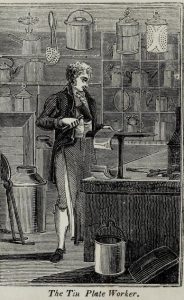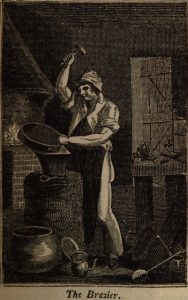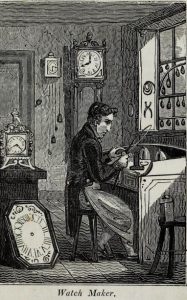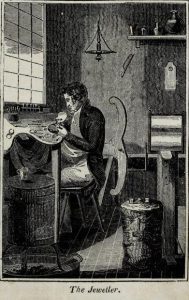
We have found smiths of all varieties on the street, some of which, such as tin and copper smithing are now redlist crafts
York was granted it’s own Assay Office by the act of 1423 when the town mark of half leopard’s head/half fleur-de-lys was instituted. The date letter was introduced in 1560, and between 1632 and 1698 the town mark changed to half rose crowned/half fleur de lys
It was temporarily suspended in 1700, then revived by and act of parliament in 1701. A new mark of a St. George’s cross charged with five lions passant, was then used until the 1714 closure when trade declined. It was reinstated again in 1778 as the trade began to grow. During the period with no assay office, work was registered to the Newcastle office
By 1858 only James Barber was using the assay office, leading to it’s final closure.
Link to the various hallmarks for York from the end of the 17th century until it closed

Tin, Copper, Pewter and Iron
John Smyth
pewterer 1454
Richard Lofthouse
In 1741 poll book as Whitesmith
Apprenticed in 1725 to William Silcock
Freeman claim 1740-41
John Stavely
In 1741 poll book as Whitesmith
There is a John Stavely Apprenticed in 1737 to William Silcock, his father is Lilian Stavely
There is also a John Staveley Or Stabler applying as Freeman by reason of Birthright in 1740-41 father William Stavely
William Wainhouse
In 1741 poll book as Whitesmith
Thomas Stodhart 1775-1826
Tinsmith and Brazier, bought house at 24 Coney Street in 1807.
Became a freeman in 1791
He also served as an alderman and is listed in the election records
John Stodhart
John Harby
apprenticed in 1792 to William Herby ? of St Martin Cum Gregory
Freeman claim 1802 in Coney street
Patrick William
Ironmonger
Joseph Wightman
Dealer in iron bedstead and Ironmonger at number 32 in 1876

Watchmakers
William Lupton Snr -1680
William Lupton -1689
Son of William Lupton Clockmaker
free 1681 died 1689
Seth Agar 1717-
son of richard agar pinner and hosier
clock and watchmaker freed 1744. showing as of coney street in 1748. house and shop near black swan to be let 2nd july 1751, moved whitby.
A ? Agar is showing in window tax register in 1751
Darling & Darling
William Darling Son of William Darling of grape lane York, shoemaker, also shop at 21 coney st.
Term of Indenture: Seven years as from 18th September 1820 to barber and whitwell Born 29th September 1806. Free 1829.
Watchmaker & Jeweller of Coney Stree 1830 poll book
at 42 in York directories of 1851. Died 6th July 1888, at starbeckaged 82.
John Cundall Arundel 1816-1893
Babtised little blake street 1816, son of Thomas Arundel glover. freed by patrimony 1839
Own business 1840 at 67 Goodramgate. Moved to 40 Goodramgate 1851. Moved to 22 coney street 17th September 1859
Died 27 august 1893 77, wife Ellen continued business
Thomas Cooke 1807-1868
Instrument and watch/clock Maker
Thomas Cooke was born in the village of Allerthorpe, near Pocklington in 1807. The son of a Shoemaker, he rrived in York c.1829 to work as a teacher.
In business as an optician, firstly at 50, Stonegate in 1837, then at 12 Coney Street in 1849.
He was to become a renowned instrument maker. Amongst his many achievements, he made the most accurate clocks of their time. He also made what was at that time the world’s largest telescope and created an observatory for the Royal Family. His telescope of 1850 is now housed in York Observatory
He built a factory in 1855 at Bishophill, named the Buckingham Works. Moved into James Barber’s old premises in 1860 where he was also noted as a watch and clockmaker. He died on the 19th October 1868 at the Buckingham Works.
There is more information on him on the York Civic Trust website here
A collection of the firms records are held at the Borthwick institute in York and some of the instruments are on display in the physics dept at York University more info here
William Pridgin
Apprenticed to William Thornton in 1756.
He became a Freeman in 1778. Watchmaker Colliergate in 1784 Poll register
Opposite George Inn, 1788 had a shop on coney st until 1793,
Although it’s possible it was the original 24, 25 or 26 Coney Street, as he is mentioned in some of the deed records of Hampston, cattle and Prince
Councillor Bootham Ward 1795
Metronome, barometer and clock maker, he also made a number of chronometers. His metronome was the first to tick and have a bell
he moved to Hull c1793.
James Carlill Bellamy
from marazion cornwall apprenticed in 1787 age 12 to william pridgin
issued 1/2 coin with constantine on in 1796
free as watchmaker 1801
advertises as watchmaker and jeweller of coney street 1801 and 1802.
chamberlain 1802
house extending to ouse for sale 1805
John Terry
proposed to make a clock for thursday market to the value of £25 1706 for his freedom
to be paid 20s pa for winding the clock. father of Ruben terry and thomas terry.
routed and captured a highway man who had robbed him 1739.
In 1741 poll book as Watchmaker
died 1757
Thomas Terry
Charles Bartliff
From new malton, father Robert.
Jewller and watchmaker at 54 coney st, 1843 & 1846 trade directory, although stock and share broker in 1845
William Dutton
Jeweller and Watchmaker 61/2 coney street in 1867 directory
Richard Heslewood -1877
Son of Thomas Heslewood Grocer, free in 1841
Initially in Blake Street in 1849.
Watchmaker in 51 Coney Street 1867 directory, 53 in 1876 one
Died 1877, business continued by his Nephew George Frederick Heslewood
George Frederick Heslewood 1852-1885
apprenticed to john Cundall Arundel june 1866 for 7 years.
Worked at 21 charles st, 1875, 49 Bishophill Drive 1876, then 51 Coney Street after his uncle’s death
died 1885 aged 33 years
Business taken over by George Norman Chapman
George Chapman -1907
from newcastle, took over George Heslewood’s business on his death at 51 Coney Street

Goldsmiths, Silversmiths, Jewellers and Engravers
john de scardeburge
Goldsmith free 1348. Unsure if he practiced in Coney Street
showing as having property on st helen stonegate paying 8d poll tax and coney st paid 12d poll tax
both in 1377
Henrici Wyman
Naturalised German Merchant
Listed as a Goldsmith and Merchant and is free in 1387
He marries Agnes Barden, daughter and Coheiress of Lister John Barden in 1387/8
A Corpus Christi pageant station in 1399 and 1416
Lord Mayor 1407, 1408.1409 and a member of the Corpus Christi Guild
Dies 5th August 1411 but is buried at St Crux, not on Coney St
His wife gifts the Scrope Mazer to York Minster
john thompson
son of henry thompson wine merchant of high ousegate abd sheriff 1602.
carried on occupation of goldsmith in house on coney st adjacent to the mansion house.
father of john thompson alderman 1683
Christopher Harrington - 1614
Unsure if he practised on the street but he is listed as marrying, being buried etc and refers to it as his Parish, so it is possible
son of Anthony Harrington tailor free by patrimony 1596
seems to also have done ceremonial sword work, as he is listed in records as putting a stone into the city’s sword, paid 2s inb 1604/5.
Also paid 15s in 1605/6 for silver and 5s labour for gilding the pendragon, hilt and pommel of the city’s great sword, plus £5 for mending and altering the city’s little sword
died on 14th november 1614 buried with arms of goldsmith’s company. his will leaves tools to his assistant James plummer, who had been apprenticed as well as his son robert a goldsmith
Robert Harrington - 1647
Unsure if he practised on the street but he is listed as marrying, being buried etc and refers to it as his Parish, so it is possible
Robert Harrington Goldsmith free by patrimony 1617
married sister of his father’s apprentice James plummer in 1624
His nephew Thomas Harrington is apprenticed on his father Thomas’ death, or forfeit his inheritance
there were often searches by wardens of the Goldsmiths Company in London to check standards. In 1635 parcels of plate were removed and upon assay on melting down were found to be substandard. he was fined and pledged not to offend again
Thomas Harrington - 1642
Unsure if he practised on the street but he is listed as marrying, being buried etc and refers to it as his Parish, so it is possible
Thomas Harrington Goldsmith free by patrimony 1625
there were often searches by wardens of the Goldsmiths Company in London to check standards. In 1635 parcels of plate were removed and upon assay on melting down were found to be substandard. he was fined and pledged not to offend again
francis bryce 1612-
son of john bryce innholder freed in 1635, no info on master
chamberlain 1649
Robert Williamson
Unsure if he practiced in Coney Street or just owned property there
listed in deed records
Robert Williamson The Younger
Unsure if he practiced in Coney Street or just owned property there
Son of Robert Williamson Goldsmith,
freeman 1624, free by patrimony 1653
Paid hearth tax in 1671 on 4 hearths in a house on Coney Street
Both listed in deed records
6 money boxes bought from him by Edward Malt on behalf of Mayor John Wallis, on 16th May 1671 of £8 1s 1d claimed form the wardens of the London Company
Leonard Thompson
son of john thompson watchmaker, apprenticed to john thompson goldsmith, alderman and mayor, in 1685 7 years.
freed by patrimony 1693.
chamberlain 1703
sheriff 1706/7
died 1711. will of wife 1719 bequeathed house in coney st to francis taylor
william busfield -1709
john busfield
Ruben Terry
father john terry clockmaker
free by patrimony 1714
In 1741 poll book as Engraver
richard caley 1741-
son of richard
freed as jeweller 1753
listed as jeweller of coney street in courant 1754, and in 1758 poll
john ellis
Ambrose Beckwith 1726-1770
Son of Malby Beckwith jeweller
Apprenticed 13th Oct 1740 to Valentine Nicholson of York.
**seems to have worked in London for a while then returned and opened a business in the premises of a Mr Baker on Coney Street in 1748, as advertised in the York Courant in 1748
Registered as a freeman in for the sum of £25 18th December 1749
Partnered with John Malton on the 19th December 1749 at the Tea Kettle and Lamp next door to the Black Swan. Partnership dissolved April 1761 then set up on his own at the Golden Cup Coney Street. He is insured by the Sun Fire Office in 1761.
Listed in the 1762 Window tax records
Councillor Bootham Ward 23rd march 1762 until his death. Chamberlain 29th Jan 1768
During the period the York assay office is closed he is registered as a goldsmith in Newcastle
He died 28th Sept 1770 aged 43. His wife then sold his business to John Hampston his journeyman, and John Prince his apprentice
** there is an Ambrose Beckwith listed with a makers mark at St Martin le grand St Paul but maybe the younger, or someone else
john malton - 1773
Free by order 1757 £20
Partnered with Ambrose Beckwith on the 19th December 1749 at the Tea Kettle and Lamp next door to the Black Swan. Partnership dissolved April 1761 then set up on his own at the Golden Cup Coney Street. He is insured by the Sun Fire Office in 1761.
Councillor 1760
Insured with sun fire office 1762-87. He stays at the Tea Kettle and lamp after partnership dissolves until 1764
Then moves to premises formerly occupied by Thomas Watkinson comb maker.
Son John apprenticed to him in 1766, dies 1773
Richard Norris-
son od robert nirris innholder beverly, apprenticed to ambrose beckwith 1763 £40
free 1770, starts his own business at Golden tea Kitchen on Coney Street in May 1770. moves to corner of Spurriergate opposite Ousegate in Nov 1770.
Bankrupt sale 1772 &73
Ambrose Beckwith the younger
comes from London in 1750 and works for Ambrose Beckwith Senior, unsure of relationship
Start his own business from 1760-65 at the Crown and Pearl Bedern Gate. Goodramgate.
Moves to the Crown and Pearl Coney Street, is mentioned in the Tork Courant on 23rd July 1765
Freeman as jeweller and goldsmith 30th september 1766 by payment of £20
Elected Councillor Bootham Ward 1767
Made Bankrupt 24th January 1769 and all stock sold. Awarded £25 from Sir Thomas White’s Gift by fellow councillors on 27th June 1769. He is back working at the Crown and Pearl Coney Street n 1771, then moves to a shop opposite the George Inn Coney Street in 1772.
Summoned to appear before magistrate for desertion of his apprentice Timothy Platt in 1776
He resigns as a councillor on 18th Nov 1779 and dies and is buried in St Andrew’s Newcastle in 1781
John Harrison -1830
John Hampston -1805
John Prince 1749-1835
Son of John Prince Bricklayer in Skeldergate.
Apprenticed to Ambrose Beckwith in 1770 free 1771. Taking on the business in a partnership with John Hampston on Beckwith’s death in 1777.
In 1796 they were joined by the Cattle brothers .
Chamberlain 1779
Councillor Micklegate ward 1783
Refused office of Sheriff 1793 and paid fine for doing so
Took lease on Scut Close Fishergate in in 1794 for £350 and built Glassworks with Hampston on it in 1797
The firm produced a wide variety of silver items from ceremonial to cutlery, teapots etc. It is highly collectable and pieces are in a number of museums around the world.
They had a number of assay marks for different items
Prince refused the office of Sheriff in 1793 and paid the fine due.
Following Hampston’s death he continued to work with the Cattles, and then after 1814 with James Barber and William Whitwell
He died in 1835
Yorkshire Gazette 25th April 1835
On Tuesday, the 21st inst., at his residence in Fishergate, near this city, after a protracted illness of upwards of four years, in the 87th year of his age, John Prince Esq. He, along with his late partner, Mr. Hamson (sic), first established the extensive and most respectable business of goldsmiths and jewellers, which, for a long series of years, has been carried on in Coney Street. In the year 1793, he paid the usual fine for being excused serving the office of sheriff of this city. Although of late years his generosity to the poor – particularly at his own door – was not regulated by that discrimination which protected him from imposition, his extensive charities will, nevertheless, be long and gratefully remembered by the needy and distressed.
George Cattle 1764-1807
con of joseph cattle, translator, and frances hall
Admitted as a freeman in 1785, he entered into partnership with his cousin Robert Cattle, John Hampston and John Prince in 1796
councillor bootham ward 1803
On Tuesday morning, suddenly, to the inexpressible grief of his family, relatives, friends, and acquaintance, Mr George Cattle, one of the firm of Messrs Prince and Cattles’ of this city, Jewellers and Silversmiths. He was one of the Common Councilmen of the Corporation for Bootham Ward, and was a man highly and truly respected by every branch of the community, for his candid, friendly, honest, and generous conduct throughout life.
Source: York Herald – 3rd October 1807
George dalby Cattle -1847
he entered into partnership with john barber and william north in 1823
married william whitwell’s widow
left firm in 1836, died in scarborough 1838 aged 41
Robert Cattle ?-1842
William Whitwell
William Whitwell, son of James Whitwell of Scoresby
Apprenticed to James Bellamy Carlill watchmaker 17th June 1802
Became james Barber’s partner in 1814, after Barber’s previous partner, Robert Cattle, had left the business by mutual consent on the 1st January 1814.
Whitwell had been working as an assistant with the firm for many years. His freeman claim was in 1822
The business advertised themselves as Goldsmiths, Jewellers and silver plate manufacturers. Watchmakers, sword cutlers, engravers and copperplate printers
The partnership was ended by the death of William Whitwell on the 24th April 1823, he was aged just 36 years. His widow mary Elizabeth Stavely, daughter of the Governor of York Castles, married George dalby cattle after his death
James Barber 1784-1857
son of john barber cabinet maker
apprenticed to hampston, prince and cattles 21 march 1800
into partnership in Robert Cattle1808. freed 1814
The partnership was dissolved in 1814.
James Barber then formed a new partnership with William Whitwell.
In 1823 he partnered with George Cattle and William North on whitwell’s death. George Cattle left the partnership in 1835. The Barker & North partnership was dissolved in 1847
Barber was Lord Mayor in 1833, fined for mayor in 1844. elected alderman 1847, resigned 1854. prime warden goldsmiths company york 1851.
he died in 1857 at tang hall. business continued by son
James silburn barber 1815-1884
son of james barber
continued father’s business on death in 1857, closed 1858 and sold to robert heselgrove and walker,
freed in 1866, died dec 1884 osbaldwick aged 68
William North 1795-1863
John Harrison
Robert Heslegrove 1817-1885
Robert Heselgrave was born c.1817 and was the son of Robert Heselgrave of Chapel Allerton.
Apprenticed 22nd May 1830 to the firm of James Barber, George Cattle & William North and stayed with the firm for 29 years
On James Barber’s death in 1857 his son tried to keep the business going in 1857, it was sold in 1859 and bought by Heslegrove and Robert Walker, including the premises at 25-26 Coney Street, although not sure if just the lease on that
This partnership was dissolved in late 1859 and in May 1860 he downsized the business and the Optician, Clock and Watchmaker, Thomas Cooke, moved into 25, Coney Street with Heselgrave still occupying No. 26. He is showing at number 12 in 1872
he died in 1885, and although his widow continued his business it was moved to stonegate
Robert Walker
John Whip
Edward Jackson ?-1859
Edward Jackson. Jackson, was apprenticed to Hampson, Prince & Cattles in 1799 and then, for Cattle & Barber for eight years he set up his business in 1815.
In1821 he let his shop to William Furnish, a draper, whilst retaining the workshop and house at the rear of the property at 14, Coney Street.
In 1824 he was listed as bankrupt however he continued to be listed as a silversmith and jeweller in the trade directories
He is listed as a draper in 1836 at 15, Coney Street.
He died on 5th October 1859, aged 73 years. His business was continued by his wife, Elizabeth.
William Dutton
working jeweller and watchmaker 61/2 coney street in 1867
john hardy
jeweller free by order 1824, purchases stock of mrs martha marshall at her jewellery, turnery and cabinet warehouse at 6 coney st.
continues business with wife. 3 medals struck
charles hardy
jeweller 6 coney st, succeeds his father’s business. also sells fishing tackle, cricket bats etc
Edward North 1822
son of william north jeweller
free 1844,
silversmith jeweller and watchmaker 24 Coney Street in 1849